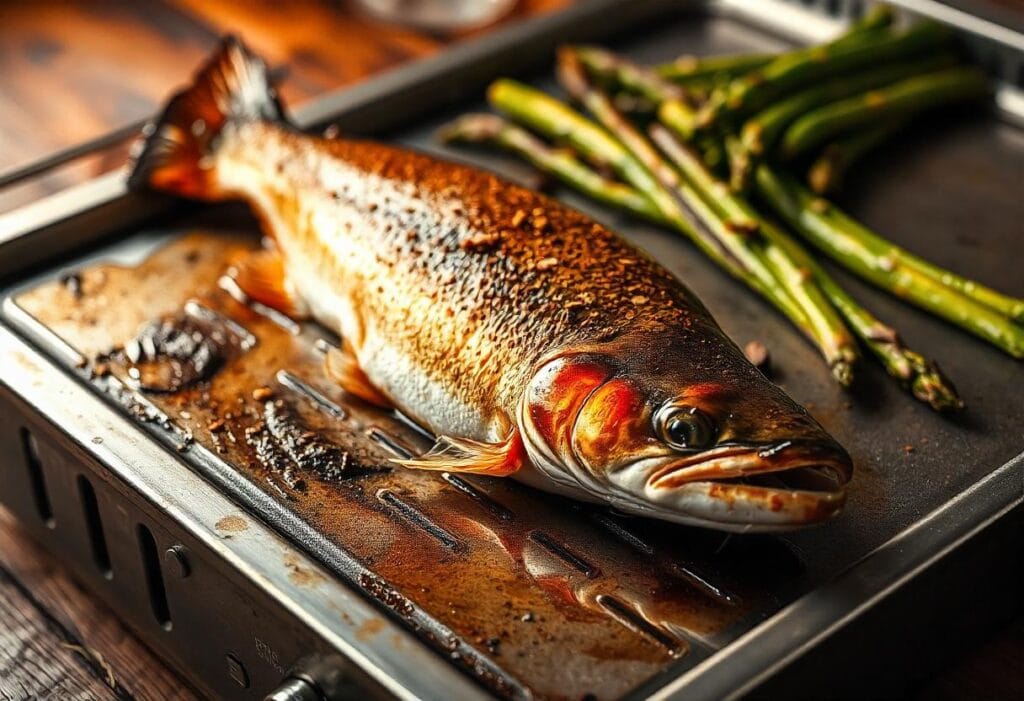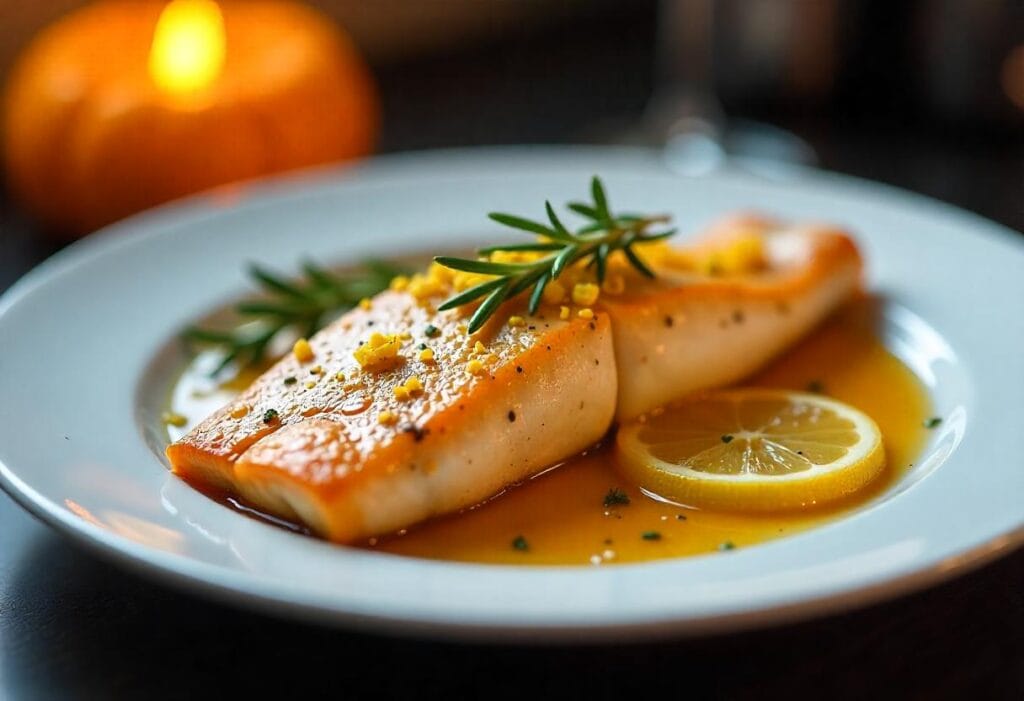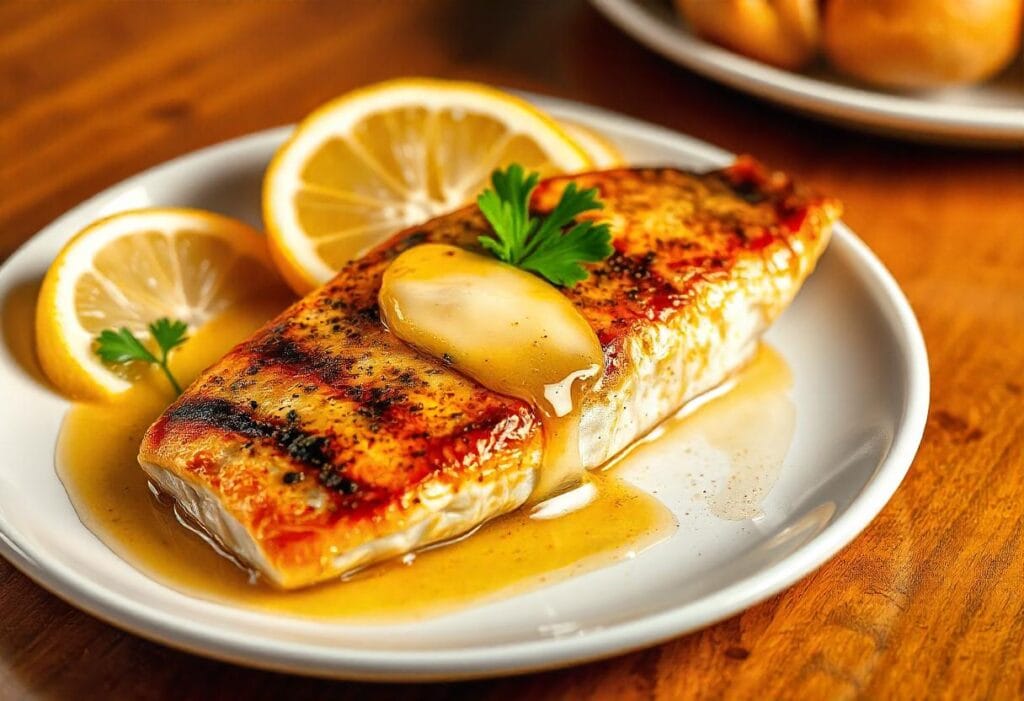Table of Contents
Many people ask ‘Is steelhead trout good to eat?’ when comparing seafood options. The short answer is yes – it’s not only delicious but also packed with nutrients Steelhead trout has become increasingly popular due to its delicious flavor, nutritional benefits, and versatility in cooking. Whether you’re a seasoned chef or a beginner in the kitchen, this fish is a great option for your meals.
👉 Before diving in, you may also want to check out Do You Eat the Skin on Steelhead Trout?, which explores whether keeping the skin on is beneficial or not.
But, what makes it so special? How does it compare to other types of fish like salmon? And most importantly, is it healthy to eat?
In this article, we’ll dive into everything you need to know about steelhead trout, from its taste and texture to its health benefits and the best ways to cook it. Let’s explore why you should consider adding this flaky, flavorful fish to your diet.
Is Steelhead Trout Good to Eat? Why It’s Popular Among Seafood Lovers
Before we dive into the details, let’s first understand what steelhead trout is and why it has become a favorite among seafood lovers. Steelhead trout is closely related to rainbow trout, but it’s different because it spends part of its life in saltwater, much like salmon. It is often referred to as a « sea-run rainbow trout » because it migrates from freshwater rivers to the ocean and back.
Its mild, buttery flavor and firm texture make it a perfect addition to a variety of recipes. But is it healthy? Is it better than other fish? Let’s find out!
Is Steelhead Trout Good to Eat for Health? The Nutritional Benefits
Steelhead trout isn’t just delicious; it’s also incredibly healthy. It’s packed with essential nutrients that contribute to overall well-being
👉 After learning about its health benefits, check out Steelhead Trout Recipes: Delicious Dishes for Every Occasion for creative ways to cook this fish!
Packed with Omega-3 Fatty Acids for Heart Health
When considering ‘Is steelhead trout good to eat?’ from a nutritional perspective, Omega-3 fatty acids are a major reason why. These healthy fats are vital for heart health, reducing inflammation, and promoting brain function
These healthy fats are vital for heart health, reducing inflammation, and promoting brain function. Fortunately, steelhead trout is an excellent source of these fatty acids. A 3-ounce serving of cooked steelhead trout contains around 1,500 milligrams of Omega-3s.
Block Quote:
« Omega-3 fatty acids are vital for heart health, reducing inflammation, and promoting brain function. Steelhead trout is a great source of these essential fats. » 🧠❤️
High in Protein and Low in Calories
If you’re looking for a healthy, lean protein source, steelhead trout is an excellent option. It provides a good amount of protein to help build and repair tissues, as well as maintain muscle mass. A 3-ounce serving of steelhead trout contains approximately 22 grams of protein, making it a filling choice for meals. And the best part? It’s also low in calories, with only around 120 calories per serving. This makes it an ideal choice for those who are watching their calorie intake but still want to enjoy a satisfying meal.
Rich in Vitamins and Minerals: What Does Steelhead Trout Offer?
In addition to Omega-3 fatty acids and protein, steelhead trout is a great source of various vitamins and minerals that support your health. Here are some of the key nutrients you can get from this fish:
- Vitamin D: Steelhead trout is a natural source of Vitamin D, which is essential for bone health and immune function. A 3-ounce serving provides about 70% of your daily Vitamin D needs.
- B Vitamins: B vitamins like B6 and B12 play crucial roles in energy production and brain health.
- Selenium: This mineral has antioxidant properties and supports thyroid function.
How Does Steelhead Trout Taste? Flavor Profile and Texture
Steelhead trout has a mild, buttery flavor that’s often described as a cross between salmon and rainbow trout. Unlike salmon, which has a richer and oilier taste, steelhead trout is slightly more delicate, making it a great choice for those who prefer a lighter fish flavor.
👉 Before we move on, you may also wonder Does Steelhead Trout Cook the Same as Salmon?. This article compares cooking techniques and flavors between the two fish.
The Mild, Buttery Flavor of Steelhead Trout
Steelhead trout has a mild, buttery flavor that’s often described as a cross between salmon and rainbow trout. While salmon has a stronger flavor due to its higher fat content, steelhead trout is a bit more delicate and less oily. This makes it a great option for people who find salmon too rich or who prefer a lighter fish taste.
Steelhead trout works well with a variety of seasonings and marinades, from herbs and lemon to spicy rubs and soy-based marinades. Its mildness makes it a versatile fish that can be cooked in numerous ways, from grilled to pan-fried to baked.
Texture: Flaky, Firm, and Delicate
The texture of steelhead trout is firm yet flaky, making it perfect for a variety of cooking methods. It holds up well on the grill and in the pan without falling apart, but it still has that delicate, melt-in-your-mouth quality. The flesh is also moist, so it doesn’t dry out easily when cooked properly.
Unlike salmon, which is often known for its dense and oily texture, steelhead trout is slightly leaner and cooks up softer without being too mushy. Whether you prefer your fish crispy on the outside or soft and flaky inside, steelhead trout can deliver on both fronts.
Comparing the Taste of Steelhead Trout to Other Fish
When it comes to flavor, steelhead trout is often compared to both salmon and rainbow trout. While salmon is known for its stronger, richer flavor, steelhead trout offers a milder taste with less oil and fat. It’s also often compared to rainbow trout, which has a similar texture but a more delicate flavor.
The best part about steelhead trout is that it’s mild enough to pair with a wide range of sides and sauces without competing for attention on your plate. Whether you’re serving it with fresh veggies, rice, or a citrus salad, steelhead trout will complement almost anything.
Is Steelhead Trout Healthy to Eat?
Now that we’ve covered the taste and nutritional benefits, let’s explore whether steelhead trout is truly healthy to eat. Steelhead trout isn’t just delicious; it’s also one of the best seafood options available for your health.
Related Read: What Is the Best Method of Cooking Trout? – Learn about the top techniques for preparing trout, from pan-searing to baking.
The Health Benefits of Omega-3 Fatty Acids
As mentioned earlier, steelhead trout is an excellent source of Omega-3 fatty acids. These healthy fats are known for their ability to reduce inflammation, improve heart health, and even boost brain function. Omega-3s are essential for maintaining healthy cholesterol levels and supporting overall cardiovascular health.
Studies have shown that people who consume more Omega-3-rich fish have a lower risk of heart disease, stroke, and even depression. So, by including steelhead trout in your diet, you’re not only enjoying a tasty fish but also taking a step toward better health.
Is Steelhead Trout Low in Mercury?
Mercury is a concern when it comes to eating certain fish, especially large predator fish like sharks, swordfish, or king mackerel. Fortunately, steelhead trout is low in mercury, making it a safe choice for frequent consumption. Like most fish, it’s best to consume it in moderation, but steelhead trout is much safer than other fish higher in mercury, such as large tuna.
The Role of Steelhead Trout in a Balanced Diet
Adding steelhead trout to your diet can be a great way to boost your protein intake while maintaining a low-calorie and heart-healthy eating plan. The fish is versatile and can be prepared in many different ways to suit your tastes.
Because it’s a lean fish, it can easily fit into diets focused on weight loss or muscle-building. It’s also a great addition to Mediterranean diets, which emphasize fish and healthy fats for overall well-being.
Is Steelhead Trout Good to Eat When Prepared These Ways? Best Cooking Methods
Steelhead trout is incredibly versatile and can be cooked in various ways, including grilling, baking, and pan-searing. Each method enhances the flavor and texture in different ways.
👉 Looking for inspiration? Check out these Steelhead Trout Recipes for a variety of delicious dishes you can try at home!
Grilling Steelhead Trout
Grilling steelhead trout is a popular method, especially during the warmer months. The high heat of the grill helps create a crispy, golden-brown crust while keeping the inside moist and tender. Grilled steelhead trout pairs well with a variety of marinades and seasonings, giving you a smoky, flavorful fish.
Steps for Grilling:
- Preheat the grill to medium-high heat.
- Brush the fish with olive oil or melted butter, then season with salt, pepper, and your favorite herbs (like dill or thyme).
- Place the fish skin-side down on the grill. Grill for 4-6 minutes per side, depending on the thickness of the fillet.
- Once the fish flakes easily with a fork, it’s ready to serve.
Tip: Use a grill basket or foil to prevent the fish from falling apart.

Baking Steelhead Trout
Baking steelhead trout is a simple and hands-off way to prepare the fish. This method is perfect for those who want to keep the fish moist while letting the flavors of the seasoning shine. You can bake steelhead trout with just a little olive oil, salt, and pepper, or you can get creative with herbs, lemon slices, and a buttery glaze.
Steps for Baking:
- Preheat the oven to 350°F (175°C).
- Place the trout on a baking sheet lined with parchment paper.
- Drizzle with olive oil or butter, then season with salt, pepper, and fresh herbs.
- Bake for 12-15 minutes, or until the fish flakes easily with a fork.
Tip: Add some lemon slices or a sprinkle of garlic for extra flavor!

Pan-Seared Steelhead Trout
Pan-searing is one of the quickest ways to cook steelhead trout, and it results in a crispy skin that enhances the flavor. This method is perfect if you’re looking for a golden-brown crust on your fish while keeping the interior tender and flaky.
Steps for Pan-Searing:
- Heat butter or olive oil in a skillet over medium-high heat.
- Season the trout with salt, pepper, and your choice of herbs.
- Place the fish skin-side down in the pan and cook for about 4-5 minutes per side, depending on the thickness of the fillet.
- Once both sides are crispy and golden, the fish is ready to serve.
Tip: For extra flavor, baste the fish with butter or garlic while it cooks.

Common Problems When Cooking Steelhead Trout and How to Fix Them
While steelhead trout is easy to cook, there are some common issues people run into. But don’t worry—each of these problems has a solution!
Overcooking Steelhead Trout: How to Prevent It
Overcooking steelhead trout is a common mistake that can lead to dry, tough fish. Since steelhead trout is leaner than salmon, it cooks faster, making it easier to overcook if you’re not paying attention.
Solution:
- Keep an eye on the cooking time. Steelhead trout cooks in about 10-15 minutes at 350°F in the oven.
- The fish should flake easily with a fork and have an internal temperature of 145°F (63°C).
- Remove the fish from the heat as soon as it’s done to avoid overcooking.
Block Quote:
« Steelhead trout cooks quickly, so be sure to watch it closely and remove it from the heat as soon as it’s done to prevent dryness. » 🕰️
Fish Sticking to the Pan: Tips to Avoid This Common Issue
When cooking steelhead trout, the fish sometimes sticks to the pan, especially when pan-searing. This can be frustrating and result in a mess.
Solution:
- Use a non-stick pan or a well-seasoned cast iron skillet.
- Oil the pan generously, and make sure it’s heated properly before adding the fish.
- Cook skin-side down first for better release and a crispy texture.
- If needed, use a fish spatula to flip the fish without damaging the fillet.
What to Do If Your Steelhead Trout Tastes Too Fishy
Sometimes, fishy flavors can be a concern when cooking any fish, including steelhead trout. This usually happens if the fish isn’t fresh or has been stored improperly.
Solution:
- Rinse the fish under cold water and pat it dry with paper towels.
- Marinate the trout in a mixture of lemon juice, garlic, and fresh herbs for 15-30 minutes before cooking. This helps mask any strong odors and adds flavor.
- Always make sure to buy fresh fish or frozen fish that has been stored properly to avoid any unwanted flavors.
How to Store Steelhead Trout to Keep It Fresh
Part of answering ‘Is steelhead trout good to eat?’ involves knowing how to keep it fresh. Proper storage is key to maintaining the quality of your steelhead trout Whether you’re buying it fresh or frozen, knowing how to store it will help keep it at its best.
Freezing Steelhead Trout: Best Practices
Freezing steelhead trout is a great option if you want to keep it for longer. Proper storage helps preserve the fish’s flavor and texture.
Steps for Freezing:
- Wrap the fish in plastic wrap or aluminum foil tightly to prevent air from getting in.
- Place the wrapped fish in an airtight freezer bag or container to avoid freezer burn.
- Label the fish with the date so you can keep track of how long it’s been in the freezer.
Steelhead trout can be frozen for up to 3-4 months.
How Long Does Steelhead Trout Last in the Fridge?
If you’re not freezing the fish, fresh steelhead trout will last in the fridge for about 2-3 days. Be sure to store it in an airtight container or tightly wrapped in plastic wrap.
How to Tell if Steelhead Trout Has Gone Bad
To determine whether steelhead trout is still fresh:
- Smell the fish: Fresh fish should have a light, ocean-like smell. If it smells strong or fishy, it’s likely gone bad.
- Check the texture: Fresh fish should be firm to the touch. If it feels slimy or mushy, it’s not safe to eat.
Frequently Asked Questions (FAQs) About Steelhead Trout
1. Can You Substitute Steelhead Trout for Salmon in Recipes?
Answer: Yes, steelhead trout can easily be substituted for salmon in most recipes. While the flavor is milder, the texture is similar, and both fish cook at about the same time. If you’re making a recipe with grilled salmon, you can use steelhead trout as a substitute for a lighter alternative.
2. Is Steelhead Trout High in Mercury?
Answer: No, steelhead trout is not high in mercury compared to other large fish like swordfish or tuna. It’s a low-mercury fish, making it a safe choice for regular consumption.
3. How Can I Tell If Steelhead Trout Is Fresh?
Answer: To ensure freshness, look for bright, clear eyes, firm flesh, and a fresh, ocean-like scent. If the fish smells overly fishy or has dull eyes, it may not be fresh.
4. Can I Eat Steelhead Trout Skin?
Answer: Yes, steelhead trout skin is edible and can be very delicious when cooked properly, especially if it’s crispy from grilling or pan-searing. If you prefer not to eat it, you can remove the skin before cooking.
5. Why is steelhead trout good to eat compared to other fish?
Answer: Steelhead trout is good to eat because it offers an excellent balance of flavor, nutrition, and versatility. Compared to other fish, it has a milder taste than salmon (making it more appealing to those who find salmon too strong), contains fewer contaminants than larger predatory fish, and is rich in heart-healthy Omega-3 fatty acids
Conclusion: Is Steelhead Trout a Good Choice for Your Next Meal?
So, is steelhead trout good to eat? Absolutely! The evidence is clear that steelhead trout is good to eat both for its culinary qualities and its impressive nutritional profile! Whether you’re looking for a heart-healthy fish rich in Omega-3 fatty acids, or a delicious, lean protein that’s easy to cook, steelhead trout is a versatile, flavorful choice. Its mild taste, tender texture, and wide range of cooking methods make it a great addition to any meal.
Whether you grill, bake, or pan-sear it, steelhead trout delivers a nutritious, tasty meal that’s good for your health and your taste buds. Add it to your next dinner plan and enjoy all the health benefits this fish has to offer!

